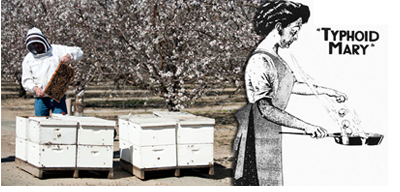
New FDA rules affect beekeeper access to antibiotics
 Honey bees may be insects, but new regulations from the U.S. Food and Drug Administration classify them with food animals and livestock. As of January 1, 2017, the FDA has
begun enforcing new rules for the purchase and use of orally administered veterinary
antibiotics. These medications are no longer available over the counter for beekeepers.
In an effort to combat the development of antibiotic-resistant bacteria, the FDA has
ruled that antibiotics used to treat honey bee diseases must now be ordered by a licensed
veterinarian, either through a prescription or a written order called a Veterinary
Feed Directive (VFD).
Honey bees may be insects, but new regulations from the U.S. Food and Drug Administration classify them with food animals and livestock. As of January 1, 2017, the FDA has
begun enforcing new rules for the purchase and use of orally administered veterinary
antibiotics. These medications are no longer available over the counter for beekeepers.
In an effort to combat the development of antibiotic-resistant bacteria, the FDA has
ruled that antibiotics used to treat honey bee diseases must now be ordered by a licensed
veterinarian, either through a prescription or a written order called a Veterinary
Feed Directive (VFD).
In order to write a valid VFD, a veterinarian is required to have an established Veterinary Client Patient Relationship (VCPR), in which the veterinarian assumes responsibility for making decisions about animal health, and is expected to have sufficient knowledge of the patient, either through individual examination or visits to the facility where the patient is managed. In the case of honey bees, this means a veterinarian must visit an apiary and personally examine a sufficient number of colonies to make a critical evaluation of honey bee health.
These new regulations may prove to be a hurdle for both beekeepers and veterinarians. Beekeepers can no longer rely on their own experience to diagnose and treat problems requiring antibiotics. And few veterinarians in any given area may have practical experience handling honey bees, or clinical experience in diagnosing honey bee diseases.
Antibiotics have long been used to treat bacterial diseases in the hive, such as American foulbrood (AFB) and European f (EFB). Outbreaks of AFB can be highly contagious, and highly lethal to honey bees. The bacteria responsible for the disease can form tough, long-lasting spores that are able to remain dormant on old beeswax combs and in old beekeeping equipment. These spores can infect new bees even after many years of sitting idly in extreme temperature conditions. Luckily for beekeepers in Arkansas, outbreaks are also quite rare. Most new beekeepers are hobbyists, who manage only a few colonies, and start with new, clean equipment. The sale or transportation of any honey bees into or within our state requires a health inspection that certifies the bees to be apparently free of disease, and the incidence of these bacterial infections has historically been very low here.
Larger beekeeping operations, especially those that have been around for many years,
and with a large number of colonies spread out over a larger geographic area, traditionally have
a greater potential for exposure to pathogens, and also a greater potential for those
pathogens to spread through an operation. With beekeeping becoming an increasingly
popular urban activity, numerous backyard hives may now be found in a relatively small
area. As all of these hobbyist colonies are managed differently, the potential for
an outbreak also increases in these areas. Perhaps the greatest threat to commercial beekeeping will be the almond pollination
season, which requires around 1.5 million colonies of honey bees to be trucked from
all parts of the country to a single part of California to pollinate a single crop.
While there to work in the almonds, honey bees come in contact with each other, and
are potentially exposed to pathogens from other hives, brought from other parts of
the country. Many beekeepers have traditionally relied on a preventative dose of
antibiotics to keep their bees healthy during this spring pollination rush. If healthy
bees from multiple operations are exposed to even a single isolated cases of AFB -
the honey bee equivalent of Typhoid Mary - the beekeeping industry could witness a
resurgence of foulbrood across the country because the beekeepers would be unable
to take immediate action against a rapidly spreading infection. While this may be
a worst-case-scenario, it's not a blow the struggling honey bee industry is prepared
to easily absorb.
Perhaps the greatest threat to commercial beekeeping will be the almond pollination
season, which requires around 1.5 million colonies of honey bees to be trucked from
all parts of the country to a single part of California to pollinate a single crop.
While there to work in the almonds, honey bees come in contact with each other, and
are potentially exposed to pathogens from other hives, brought from other parts of
the country. Many beekeepers have traditionally relied on a preventative dose of
antibiotics to keep their bees healthy during this spring pollination rush. If healthy
bees from multiple operations are exposed to even a single isolated cases of AFB -
the honey bee equivalent of Typhoid Mary - the beekeeping industry could witness a
resurgence of foulbrood across the country because the beekeepers would be unable
to take immediate action against a rapidly spreading infection. While this may be
a worst-case-scenario, it's not a blow the struggling honey bee industry is prepared
to easily absorb.
So, while incidence of AFB and EFB are traditionally low, there is potential for a resurgence in the near future. Because veterinary house calls can be expensive, some beekeepers may delay until a situation is too late, or fail to contact a veterinarian at all. If, in the face of an outbreak, a frustrated beekeeper simply walks away and allows sick hives to die out, then all colonies within several miles are potentially exposed. From a single incident the radius of affected colonies could widens exponentially as more cases go undetected or untreated.
Many beekeepers have complained about these rules, seeing them only as unnecessary burden on themselves, and merely a financial benefit to veterinarians. However, beekeepers should not assume that veterinarians are eager to get involved with honey bees either. These regulations have been put into place from the federal level, as a one-size-fits-all solution to a legitimate concern about the misuse of important medications. Veterinarians will have to decide for themselves if they will take on honey bees and beekeepers as clients, and seek out the appropriate training to be able to provide these services.
If you are a beekeeper who needs help finding a veterinarian with honey bee experience, consult the latest Farm Animal Veterinarian Directory for Arkansas. If you are outside of Arkansas, you can contact your local Department of Agriculture, your local County Extension office, or your state's Veterinary Board to help you locate the appropriate contacts for your area.
The beekeeping medications affected in this ruling include oxytetracycline (Terramycin), tylosin (Tylan) and lincomycin (Lincomix). So far, Fumagilin, an antibiotic used to treat Nosema disease, has not been made subject to the new requirements.
It is important to note that, while antibiotics can suppress clinical symptoms of AFB in honey bees, it does not cure the disease, but rather renders it temporarily inactive. The bacteria, Paenibacillus larvae, is able to form a resilient spore that can survive extreme conditions of heat and cold for many years. When AFB is found, beekeepers are required by law to destroy infected hives by burning, and quarantine the rest of the apiary. As heartbreaking as it can be to a beekeeper, permanently removing the source of infection is the only way to protect other hives in the apiary, and other nearby hives, that will naturally try to rob out dying colonies and further spread the bacterial infection. It is possible to treat hives and combs with gamma radiation, but this is not a practical solution for beekeepers.
In the case of EFB, the bacterium Melissococcus plutonius does not form a long-lived spore, and honey bees can recover from a mild infection. Traditionally, antibiotics are mixed with powdered sugar, and fed to the bees. The treatment is most effective when the brood cycle of the honey bee is temporarily broken, either by removing or caging the queen for a couple of weeks. This allows the adult bees to ingest the medication, and all healthy brood is allowed to develop, but sick brood dies and is removed. By the time the queen begins to lay again, the disease had been eliminated. However, it is possible for bacteria to remain on the comb and woodenware, and a resurgence can occur. With the additional step of shaking all adult bees onto new foundation in a new box, and feeding heavily with sugar syrup, all contaminated comb is destroyed, and the broodless adult bees will spend the next weeks drawing new foundation, unable to infect any new larvae. If the infection level was mild, it is possible for this method to work without the antibiotic treatment.